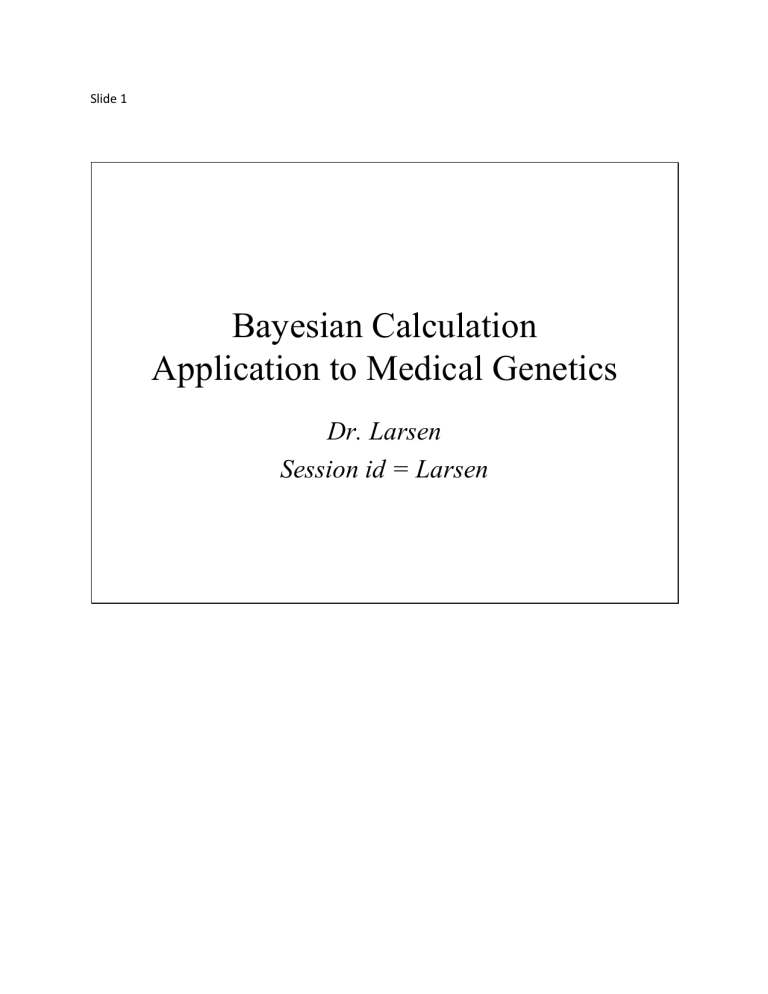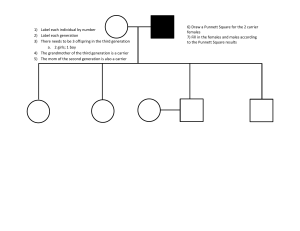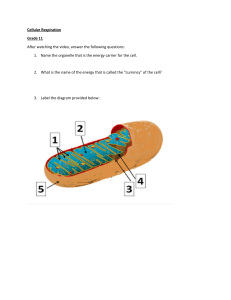
Slide 1 Bayesian Calculation Application to Medical Genetics Dr. Larsen Session id = Larsen Slide 2 Objectives • Apply that Bayesian calculation is done when both of the two conditions are met: – presence of doubt on carrier risk of a person, and – presence of additional information influencing the risk for that person • Demonstrate ability to include Bayesian calculation into risk calculation of genetic pedigrees including information from offspring phenotype, lab values or physical examination, or reduced penetrance • Sample questions in Canvas • Reading: Emery’s elements of medical genetics p94 Slide 3 When to Use? • When doubt about risk exists, and • When there is additional information • Most often additional information is – – – – Phenotype of the person itself Phenotype of offspring Test results (uncertain) Penetrance different from 100% In other words: if a person has a 0% or a 100% risk for something (certainty) then Bayesian analysis is not relevant. Bayesian analysis is only relevant for in between values. Slide 4 Simple Examples • Sister of a hemophilia patient has a risk of 1/2 for being a carrier; what happens if she has an affected boy? • Her risk changes to 1 (she is for sure a carrier) • In a family with an albino, an unborn sibling has a risk of ¼ for becoming an albino, and of ½ for being a heterozygote; what happens after birth of a baby with normal phenotype? • The baby’s risks become 0 for being an albino and 2/3 for being a heterozygote These are both things you know from previously. The relevance here is that there is a step wise progression: you have one risk, then an additional observation occurs leading to a recalculation of the risk. There is, however, no reason to use a formal framework for these two cases, they are easy enough that you can do them without. The rest of the lecture is about how to use a framework to handle slightly more complex cases. Slide 5 Example 1: healthy sons for X-linked recessive Slide 6 DMD sons: what is the risk that the daughter is a carrier? No other known cases in family 1. 2. 3. 4. 5. 1 1/2 1/3 1/8 1/4 Slide 7 X-linked recessive trait (e.g., DMD) • II-2 has two healthy and no affected sons; what is her risk of being carrier? I will go through this calculation in class. The next slide contains the same calculation, but seeing it developed in a stepwise fashion might be valuable. Slide 8 Calculating the Last Risk Possibilities II-2 is a carrier (Xx) II-2 is not a carrier (XX) Prior probability 1/2 (before birth) [Prior] 1/2 Observation (she has ½ x ½ = ¼ two healthy sons)[Conditional] 1 1/8 Product, adjust to common base [Joint] 1/2 = 4/8 (sum=5/8) Throw away divisor, 1/5 divide by sum [posterior] 4/5 Notice that final result is the probability for II-2 herself being a carrier, it does not say anything about passing the bad allele on. In other words, the number circled at the bottom is the new value for the text at the top of the column. The statistical designations for these rows are: prior, conditional, joint, and posterior. Slide 9 The Second Row (conditional/observation) • The value is the Probability(observation given the genotype listed above the column) • In the previous slide for the first column, that would be Probability (healthy sons when genotype is Xx) Slide 10 Continued: what is the risk that her child will have the disease? • II-2 had carrier risk of 1/5 • Passing on would be ½ • And probability of son would be ½ • Result 1/20 Multiply all rows together. Reminder from semester 1: the reason we use ½ for son is that daughters do not become affected (or at least only have a few % risk of doing so, something we ignore in Bayes calculations) Slide 11 Example 2 reduced penetrance for AD Slide 12 Reduced penetrance: AD gene, 80% penetrance. What would be the risk of an offspring for having the disease? 1. 2. 3. 4. 5. 6. 0.5 1.0 ~0 0.4 0.8 0.2 Slide 13 What is the risk for the offspring (III-1) for being affected? 1. 2. 3. 4. 5. 6. 1/4 1/6 ~0 2/9 1/15 1/12 Slide 14 Strategy • First calculate the risk that II-1 is a carrier (Bayes) • Secondly, calculate the risk of passing on times risk of being affected Slide 15 Bayes table for that example II-1 Carrier Non-carrier Prior ½ ½ Healthy (conditional) 2/10 1 Joint/product 1/10 5/10 Posterior 1/6 (5/6) Sum 6/10 Remember that 1/6 is the new carrier risk; it has not taken into account probability for passing on or for fetus becoming affected Slide 16 Example 3 disease with late onset and physical exam/lab results Slide 17 Bayes Formula: Integrating Other Observations • Mr. Jones is offspring of a person with Huntington Disease (HD) • Mr. Jones is 38 and does not show any signs of HD • How likely is it that Mr. Jones has the gene for HD? Slide 18 HD and Age of Onset Not affected Affected In an exam question, expect a written presentation of the results rather than a graph. It will almost always take the form of “the risk for being carrier and affected is X”. Because the person you are interested in is healthy, no affected, the value you need is risk for being carrier and healthy, which is 1 – X. Slide 19 Calculating the Risk Possibilities Mr. Jones is a carrier (Aa) Mr. Jones is not a carrier (aa) Prior probability (from 1/2 known dominant inheritance) 1/2 Observation (Mr. Jones has no symptoms) 1/3 1 Product, adjust to common base 1/6 1/2 = 3/6 sum=4/6 Throw away divisor, divide by sum 1/4 3/4 Slide 20 Example 4 Two different observations Slide 21 Two different observations • E.g., lab data and offspring • Use two lines for observation and multiply both with the prior Slide 22 Two people are affected with DMD. II-2 has normal CK (70% of DMD carriers have elevated CK). What is her risk of being a carrier? 1. 2. 3. 4. 5. 3/43 5/32 1/16 7/62 7/47




